SURFING IN JAPAN
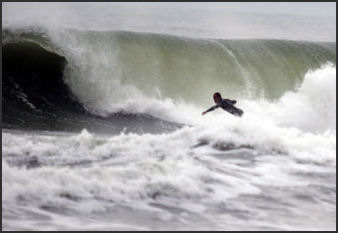
surfing in Chiba Tsurigasaki Beach (64 kilometers, 40 miles, from Tokyo in Ichinomiya, Chiba) was contest site for surfing event at the 2020 Olympics Games (held in 2021). To ensure quality surf, the contest featured a waiting period of 16 days and ending up being held right after a typhoon. The beach attracts over 600,000 surfers every year. It has world-class waves but only when the conditions are right. The beach is a 30 minute walk, or a 6 minute taxi ride from Torami Station on the JR Sotobo Line.
Aoshima Beach (just south of Miyazaki City) is regarded as one of Japan’s best surfing spots, boasting fine balmy weather and the blue Pacific waters. Set in this ideal location, Surf City Miyazaki is the main activities center, with surfing lessons, surfboard rentals as well as lessons and rentals for standup paddle boards (SUPs). It’s also a haven for yoga enthusiasts, with instructors certified in a wide range of yoga schools leading classes in the studio, on the beach, or even right on the water. Hikes along the beach or in mountain are popular. Website: surfcity-miyazaki.jp
Japanese are very keen on surfing and outdoor and adventure sports in general. For more information and lists of companies involved with the activities listed below contact the Japan National Tourism Organization. Websites: Outdoor Japan Outdoor Japan Surfing: Websites: Japan Surf Japan Surf ; Global Surfer Report on Japan Global Surfer ; Cruises: Not so many cruise ships stop in Japan and those that do are often on long round-the-world type cruises. You google “Cruises Japan” and see where it takes you.
Diving and Snorkeling
Diving and Snorkeling in Japan waters is good but not on the level of the Caribbean or Fiji. The water is sometimes cold and the visibility in many places at best is around to 30 to 50 feet. What makes diving in Japan interesting though is you can see sea life and natural wonders found nowhere else in the world.
There are PADI-member dive outfitters located in many places in Japan. They offer air filing, gear rentals, instruction and transportation to the diving areas. Snorkeling is usually offered on the same boat trips that take scuba divers out but snorkelers often see a lot less.
PADI (Professional Association of Diving Instructors) has more than 10,000 affiliated dive center, resorts and individual instructors worldwide.
For more information about diving contact PADI International (Website: PADI ) 1251 East Dyer Road #100, Santa Ana, CA 92705-5605, ☎ 714-540-7234). In Japan, you can buy diving and snorkeling guides.
Dive Sites
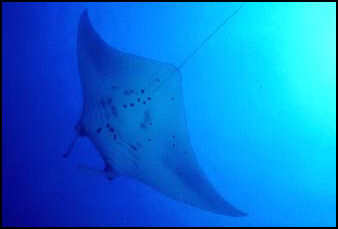
manta ray in Okinawa The Japanese are enthusiastic divers and will dive pretty much anywhere. Japan has 6000 mile of coastline and the dive sites include reefs, freshwater pools, caves, wrecks, kelp forests, unique fjords and abalone beds.
The main dive sites are in Okinawa and the islands between Okinawa and Taiwan. Okinawa contain some of the world’s northernmost tropical coral reefs and a great variety of coral. Thus far 370 different species of coral and 1,000 species of reef fish have been counted. Coral bleaching has become a problem in some places.
On the Main Island some visitors take glass bottom bota trips and walk on the bottom of the ocean in weighted boots with headgear connected to an oxygen hose. Some of the best snorkeling and diving os on the nearby small islands of Iheya-jima, Izena-jima. Kume-jima and the Keram-retto Islands.
The best coral reefs are off Ishigakjima and Iriomotejima. Three-kilometer-long Shiraho reef off Ishigaki Island contains at least two thirds of the number of species found in Australia's Great Barrier Reef and some world's largest, oldest and finest colonies of blue coral.
Sabiura (near the southern point of Wakayama Prefecture near Osaka) is the home of the northernmost colony of table coral. It is nourished by warm waters carried north from the Kurshiro Current. Kushimoto Marine Park contains 120 species of coral and a great variety of fish normally associated with more southern seas. In seas off Tanabe, Wakayama Prefecture, scuba divers flock to see fluorescent seas anemone in water 40 meter below the surface that at their most intense when waters are fairly clear in the winter time. The sea anemones belong to a new species discovered in 2004.
Suruga Bay (70 miles southwest of Tokyo) is an extraordinary body of water. Bordered by Mt. Fuji to the north and the mountainous Izu Peninsula to east, this 40-mile-wide bay drops to a depth of 8,000 feet a few miles from shore. On the weekends the shore near the reefs are overrun with Japanese scuba divers in bright-colored wet suits. Futo (on the Izu Peninsula) is a popular spot with scuba divers. Divers see lionfish, large squid and sea anemones. Some 25,000 divers visit the spot every year. The Kuroshio currents keeps the waters warm and clear.
Hachijo-jima Island (175 miles south of Tokyo) is the second largest and southernmost of the Izu islands. Scuba divers here can observe underwater lava formation, spot turtles dolphins and see schools of tuna. The lack of beaches doesn’t keep surfers away.
Websites: Dive Japan Dive Japan ; Dive Centers in Japan Dive Centers.net ; Diving Liks Japan Diver.com
Dolphins can be seen in waters all around Japan. By one count there are 569 cape and bottlenose dolphins living in Kinko Bay off Kagoshima. Several water parks and aquariums sponsor dolphin shows. Chichijima in the Ogasawara Islands (500 miles south of Tokyo) sponsors swimming with dolphins trips. Website: Dolphin Club Miyakejima Dolphin Club Miyakejima
Suruga Bay
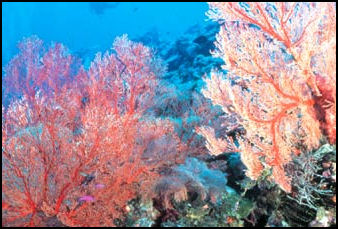
Suruga Bay (110 kilometer southwest of Tokyo) is an extraordinary body of water. Bordered by Mt. Fuji to the north and the mountainous Izu Peninsula to east, this 40-mile-wide bay drops to a depth of 8,000 feet a few miles from shore. On the weekends the shore near the reefs are overrun with Japanese scuba divers in bright-colored wet suits; on the weekdays most of the people around are fishermen.
Creatures found in the depths of Sugara Bay includes 23-foot-long sleeper sharks at 4000 feet, chimaera, with wing-like fins at 1450 feet, bioluminescent lantern sharks at 3000 feet, and white eels that use their pelvic fins to locate food at 7000 feet. These creatures all tend to move slowly to conserve energy. Other fish have transparent skin with a sensitive pineal gland that helps them determine night from day in this permanently dark world.
Twelve foot crabs, living at 450 feet, are sometimes called dead man's crab after their habit of feeding on drowned humans. These crustaceans, take 10 years to mature and may live to a ripe old age of 50. [Source: David Doubilet and Eugenie Clark, National Geographic, October 1990] Website: Wikipedia Wikipedia
Futo (on the Izu Peninsula) is a popular spot with scuba divers. Divers see lionfish, large squid and sea anemones. Some 25,000 divers visit the spot every year. The Kuroshio currents keeps the waters warm and clear. Website: Marine Photographers marinelifephotography.com
See Separate Article SHIZUOKA, IZU PENINSULA AND IZU ISLANDS factsanddetails.com
Wakayama Diving
Stone corals and tropical fish are found along the coast of the Kii Peninsula due to the effects of the warm Kuroshio current. Diving and snorkeling in these regions allow enjoyment of the beautiful underwater scenery.
Kushimoto Marine Park (4 hours from Tennoji, Osaka by the Limited Express Kuroshio) contains 120 species of coral and a great variety of fish normally associated with more southern seas. These can be observed with scuba diving gear in the marine park or through a window of an observation area 6.3 meters below the surface and a 140 meters out at sea. Waters in Kushimoto, right at the bottom of Wakayama prefecture, the southernmost point of Japan’s main island, Honshu, never goes below 15 degrees Celsius. The abundant marine life varies from tiny inland sea species to the larger migratory fish in the open ocean. PADI-affiliated Kushimoto Dive Station caters to all skill levels and is a stone’s throw from Kushimoto Station. . Kushimoto Dive Station: Address: 642-1 Kushimoto-cho, Kushimoto, Higashimuro-gun, Wakayama kushimoto.com
Sabiura (near the southern point of Wakayama Prefecture) is the home of the northernmost colony of table coral. It is nourished by warm waters carried north from the Kurshiro Current. Tanabe attracts scuba divers seeking fluorescent seas anemone in water 40 meter below the surface that at their most intense when waters are fairly clear in the winter time. The sea anemones belong to a species discovered in 2004.
Diving Around Okinawa
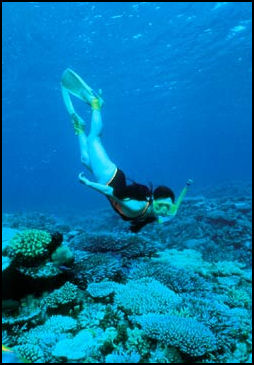
Okinawa contain some of the world’s northernmost tropical coral reefs and a great variety of coral. Thus far 370 different species of coral and 1,000 species of reef fish have been counted. Coral bleaching has become a problem in some places. Thirty-five kilometers from Naha is group of 30 or so islands is popular with divers for its clear waters (visibility up to 30 feet). There are 13 divide shops on Tokashiki Island,
On the Main Island some visitors take glass bottom bota trips and walk on the bottom of the ocean in weighted boots with headgear connected to an oxygen hose. Some of the best diving in Okinawa is off Okashima Island in Zamamison, To prevent damage there the local government restricts the number of diving permits given out. Some of the best snorkeling and diving os on the nearby small islands of Iheya-jima, Izena-jima. Kume-jima and the Keram-retto Islands.
To boost tourism to the islands the government wants to build an airport on the island with a runway large enough to accommodate jumbo jets. The only problem is they want to build the runway into a bay blessed with large colonies of coral. Websites: Diving Spots in Okinawa visitokinawa.jp ; Dive Sites Reef Encounters Dive Bum Okinawa Dive Bum Oki ;
Yoronto Island (23 kilometers from Okinawa) is small island know for its sea turtles, traditional sweets, salt industry and thatch-roof folk village. The island is very remote and quiet. The people that lived here were known for being self sufficient and producing all their own things until the 1960s. The best turtle spotting place is a five minute boat ride from Chaban Port. It is not uncommon to see a dozen different turtles in one dive. The turtles like to come to this spot to sleep.
Naha is also the jumping off point for sightseeing tours of the Ryukyu Islands. Wonderful islands just an hour away and accessible by ferry boats are great for snorkeling and diving. The best coral reefs are off Ishigakjima and Iriomotejima near Taiwan. Three-kilometer-long Shiraho reef off Ishigaki Island contains at least two thirds of the number of species found in Australia's Great Barrier Reef and some world's largest, oldest and finest colonies of blue coral.
Miyako Islands (190 miles southwest of Okinawa) contains nice beaches and snorkeling and diving reefs. Hirara is the largest town on the largest island. The islands largely escaped the ravages of World War II and there are remnants of the Ryuku Culture.
Yaeyama Islands (between the Miyako Islands and Taiwan) are famous for black pearls, star-shaped sand and the Iriomote wildcat. Home to nice beaches and snorkeling and diving reefs and large wilderness areas, they have been described as the Galapagos of Asia because of the high number of unique birds, plants and butterflies found there,
See Separate Articles: OKINAWA factsanddetails.com; RYUKYU ISLANDS NORTH AND SOUTH OF OKINAWA factsanddetails.com
Kerama Islands
Kerama Islands (32 kilometers southwest of Okinawa) is a group of islands in Okinawa Prefecture attract divers from around the globe with their extensive coral reefs and ultra-clear water. The sea around the islands has been nicknamed "Kerama blue" and can be transparent up to 30-meters deep. It can be quite crowded as divers descend from tour boats one after another into the azure sea to explore the colorful coral and multitude of fish species. Sea turtles are often spotted. [Source: Atsuki Kira, Yomiuri Shimbun, October 6, 2012]
Atsuki Kira wrote in the Yomiuri Shimbun: “The islands' popularity has been hard on the reefs, causing local entities to mull limiting access to dive sites. In a bid to both support the tourist industry and preserve the natural environment, local governments and nature organizations have begun to discuss restricting the number of divers to the area, with special priority given to users who are willing to contribute to nature preservation.
“Tourism to the Kerama Islands took off during the economic bubble of the 1980s, at one time logging more than 200,000 visitors per year. A diving boom prompted tour companies to adopt larger vessels that could sail direct from Okinawa Island, about 40 kilometers away. Yoshimitsu Higa, chairman of the diving association on Akajima, one of the Kerama Islands, recalled the rough-and-ready practices of those days "Some operators anchored their vessels by tying chains around the coral," he said.
“Coral was damaged from being touched by divers or inadvertently kicked with their fins. Some boats dumped sewage in the area, further harming the reefs. A more recent problem has been the explosion of crown-of-thorns starfish and conches that devour coral. Rising sea temperatures are blamed for the species' invasion, which have proved a nuisance to deal with.
“Local governments have turned to legal measures to strike a balance between tourism and conservation. The villages of Zamami and Tokashiki in the islands have used the Law on Promotion of Ecotourism, which allows for natural resources such as coral that are vulnerable to excessive human contact to be designated "special natural tourism resources." The designation allows limits to be placed on access. The two villages applied for local waters up to 30-meters deep to be designated special tourism resources. The applications were approved in June by the Environment Ministry and other entities — a national first. Zamami and Tokashiki continue to study regulations such as restricting the number of divers permitted to enter certain areas and allocating specific zones to certain businesses. Ideas they like will be made into municipal ordinances.
Dolphin Watching in Japan
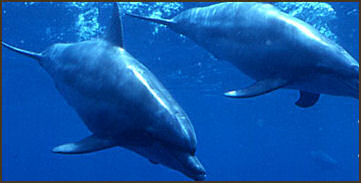
Miyakejima Island (120 miles south of Tokyo) is a volcanic island with 240 species of wild bird and dolphin swimming tours. The island has a circumference of 36 kilometers and is the third largest of the Izu islands. "Kusaya," horse mackerel dipped in salt water and dried in the sun, is a specialty of the island
Mikurashima (30 kilometers south of Miyakejima) is known as the "island of the dolphins." About 270 Indo-Pacific bottlenose dolphins are known to inhabit the waters around Mikurajima. Dolphin-viewing trips are popular. Website: Tokyo Islands tokyo-islands.com ;
Amakusa Islands (west of Kumamoto) is known for a spectacular drive along the five painted bridges that link the islands. Indo-Pacific bottlenose dolphins (Tursiops aduncus) are found throughout the year in the sea between the Amakusa Islands and the Shimabara Peninsula. Dolphin watching is available.
Shigeru Ueda wrote in the Yomiuri Shimbun: “I went down to the ocean to do some a dolphin watching. It’s a year-round sightseeing attraction, and whenever ships set out to sea, there is a 99 percent chance of spotting the dolphins. After about 20 minutes of sailing, I saw dolphins swimming parallel to the boat as if they had come to welcome us. Getting There: From Haneda Airport, it takes 1½ hours to Fukuoka Airport and another 35 minutes to Amakusa Airport. Flights from Kumamoto Airport to Amakusa take 20 minutes. From Kumamoto Airport, it takes about 2½ hours by car to the central part of Amakusa city. Website: Amakusa Tourism Association: t-island.jp/en; Tel: (0969) 22-2243.
See Separate Article SHIZUOKA, IZU PENINSULA AND IZU ISLANDS factsanddetails.com ; KUMAMOTO, AMAKUSA AND SAGA: CASTLES, POTTERY AND DOLPHINS factsanddetails.com
Whale Watching in Japan
Whale Watching Tours are enjoyed by about 100,000 people every year in Japan. In Naha and Zamami in Okinawa, they are organized by several groups including the Zamami Whale Watching Association. A two-hour tour costs about ¥5,000 person and leaves from Zamamai on the Keram islands, which is reached by a one-hour high-speed ferry that leaves from Tomari Port in Naha at 9:00am and cost about ¥5,000 for a round-trip ticket.
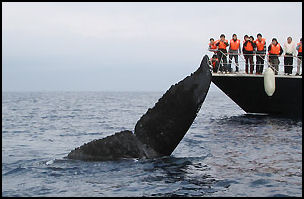
Every year between January and April, hundreds of humpback whales migrate through the area. The humpbacks have only been seen in the area since the mid 1990s but about 270 of them have been counted in the peak season.
The trips involve going to a spot where whales are usually seen and waiting. When a whale is spotted the boat races off for a closer look, but always maintains a distance of greater 100 meters. The whales rarely dive for more than 15 minutes so when one dive the guides does his best to predict where it will show up next.
Sperm whales are often seen at a site about one hour from Chichijima in the Ogasawara Islands (500 miles south of Tokyo) . In the late autumn mothers are spotted with their calves. Humpback whales breed in waters off the island from December to May, peaking in February and March. According to Ogasawara Whale Watching Association about 20 whales a day can be seen from the Chichijima island observation tower if the conditions are good. The waters off the island are 200 meters of shallower with gentle waves, providing good breeding conditions.
Websites: whale watching Inland Sea whale route.com ;Ogasawara whale watching Ogasawara whale watching ; whale watching in Okinawa Kerama Islands whale watching
Turtle Watching in Japan
Yakushima and Tanegashima islands in Kagoshima Prefecture off the southern coast of Kyushu are the two main turtle egg-laying areas in Japan. Yakushima is the largest nesting site for loggerhead turtle in the North Pacific and the northernmost landfall in Japan for green turtles. About 4,000 loggerheads came ashore in 2005.
The primarily egg-laying areas around the town of Kami-Yaku on Yakushima. The loggerhead nest primarily on three beaches — Maehama, Inakahaa and Yotsusehama, which are collectively known as Nagatahama on the northwest part of the island . Some 5,051 turtles came ashore here in 2004. The second main area is around Nakatane on Tanegashima island. A total of 338 turtles came ashore here.
The egg-laying season for the sea turtles from late April to July with hatchlings making their way to the sea from July to September. About 100 people show up every night to observe the females come ashore and lay their eggs. Sometimes they create a disturbance with car lights and noise. There have been cases of turtles coming ashore and not laying any eggs and baby turtles not being able to emerge from their holes because the sand had been disturbed. The Yakushima Umigame Kan is non-prot organization run by volunteers that is dedicated to helping the turtles.
Maeham and Inakahama (northwest side of Yakushima, north of Nagata) is one of the world's most important nesting sites for loggerhead turtles. The nesting season is from mid-May through the end of July. The sites are often fill with tourists who surround the turtles with flashlight and cameras and can’t suppress their desire to touch the turtles shell and flippers.
Yoronto Island (23 kilometers from Okinawa) is small island know for its sea turtles. The best turtle spotting place is a five minute boat ride from Chaban Port. It is not uncommon to a dozen different turtle in one dive. The turtles like t to come to this spot to sleep.
Chichijima in the Ogasawara Islands (500 miles south of Tokyo) is home to Japan’s only aquarium dedicated to turtles, particularly green turtles, and most of the hotels in the Ogasawara Islands. Activities on the island include swimming with dolphins and whale watching and turtle watching. The number of green turtles coming ashore to lay their eggs is increasing at a rate faster than anywhere else in the world.
Fishing in Japan
Deep-sea fisherman go after swordfish, blue, black and Pacific marlin, mako, thresher and hammerhead sharks, and yellow tail and yellowfin tuna. Sport fishermen can enjoy surf casting, night fishing and long line fishing and slow or fast trolling. Deep sea fishing is usually organized through charter boat companies in the major seaside resorts and is expensive. Many fishermen fish from beaches, piers, rocks and breakwaters and catch a variety of fish.
For more information contact Japan National Tourism Organization. Websites: Fishing Japan Fishing Japan ;Fishing Japan top sites Fishing Japan top sites
Sailing is expensive in Japan, which is a pity because it has some of the world's best sailing conditions: clear waters, deep coves, dramatic headlands, sandy shores, and winds and a climate that allow year-round sailing. Websites: Sail Japan Sail-Japan ; Outdoor Japan Outdoor Japan ; Boating links tspsJapan
Image Sources: 1) Chiba Tourism 2) 3) 5) 7) Okinawa Convention and Vistors Bureau 4) 6) Tokyo Islands
Text Sources: New York Times, Washington Post, Los Angeles Times, Daily Yomiuri, Times of London, Japan National Tourist Organization (JNTO), National Geographic, The New Yorker, Time, Newsweek, Reuters, AP, Lonely Planet Guides, Compton’s Encyclopedia and various books and other publications.
Last Updated: June 2023
